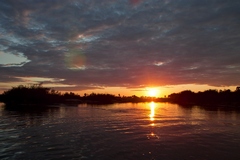
Some spectacular sunsets can be captured
on camera, especially from a boat after an
evening of fishing in the slower flowing parts
of the river
Nyerere is blessed with a subtropical climate all year round. Although July is 'Winter' the night time lows are around 18-20 C and during the day the temperature can easily reach 35 C.
Even first thing in a morning the air is quite warm and humid. The sky is definately cloudier on this side of the Udzungwa mountains although the amounts are very variable from day to day. It is pleasant enough to sit outside in an evening with no need to wear a sweater.
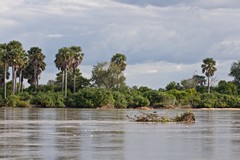
The main river flows fast and wide, and
carries a lot of vegetation that has fallen into
it where the banks have been undercut
The clouds do mean that there is a good chance of a spectacular sunrise/sunset, and especially so when seen from a boat on the Rufiji river. The night sounds from the river include a myriad of frogs, the sounds of hippos grunting, and the splashes made by crocodiles as they snap up fish. There are also the tiny emerald green winking lights of fireflies to add a fairytale like quality to the experience of being there.
The rainfall in Nyerere is much heavier than Ruaha, because it is on the coastal plain and the Monsoon rains come in from the East from November to May, and so have no mountains to stop the rainfall from reaching the Reserve. There was even a light rain shower while we were there at the beginning of July.
The river is 600km long and it drains most of the south eastern portion of the East African plateau (180,000 km2). Depending on the success of the rains, the river is well up on its banks, flowing quite strongly, and carrying lots of rafts of floating vegetation derived from bankside erosion downstream towards the sea. Consequently many of the boat safari activities are spent on the lakes connecting to the river, as the crocodiles and hippos tend to congregate in these quieter areas.
The bush seems very thick and green even at this time of the year, although much of the savanna grass is dried yellow and dying away. Some of the small trees in the drier areas are losing their leaves and are beautiful shades of russet and yellow. Most of the acacias and terminalias are green; some apparently dead ones are shades of silver grey and brown.
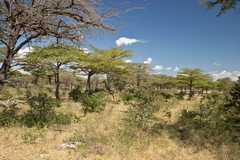
The terminalias are mostly still green. The
grass, although long, is starting to dry out
Apart from impalas and giraffes, game is still relatively scarce (although not enough to put anyone off going) due to presence of seasonal waterholes and marshes further away from the Rufiji river.
We visited the outskirts of one such marshy area, maybe a half mile wide and full of lush green vegetation, after driving through miles of dry acacia bush. The marsh was impenetrable by car but the area around it was alive with good numbers of giraffes, wildebeeste, zebras, impalas, and quite a few kudu. There were troops of vervet monkeys in the trees and even a couple of hippos could be seen in the small ponds that were visible though gaps in the bushes. Until these seasonal marshes and ponds dry out the game remains well dispersed thoughout the Reserve and is not reliant upon the permanent rivers such as the Rufiji.
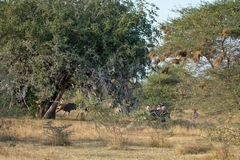
On the outskirts of a seasonal swamp we
found herds of impalas and wildebeeste.The
wildebeeste were often skittish and ran off
as we tried to approach them. Zebras also
seemed quite wary. We wondered if this was
due to hunting further South in the Reserve
Elephant numbers have fallen drastically in the Reserve due to poaching on an Industrial scale which has ramped up since 2006, from 70000 to 13000 by late 2013. The Northern sector of the park where the safari lodges are, is probably the safest area for the remainder, and they can still be seen fairly easily, although it was reported that some families are more scared and some of the bulls are more aggressive than they used to be. There are also an increasing number of tuskless females being born.
Whether this is a selective process due to poaching or not is inconclusive but it is sad to see elephants without their hallmark ivory.
There are now increased anti poaching measures in place and, as of 2018 the poaching situation is hugely reduced. The government is much more commited to conservation measures. Recent reports say elephants are being seen more and they are also less stressed. Estimates released in 2023 show that the overall population of Tanzania's elephants has recovered to 81000 from a low of 43000 in 2014. The numbers for Selous were not given, however, things are looking much brighter.
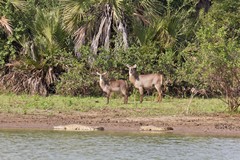
A boat is the perfect way to observe game
in Selous. Animals seemed more relaxed
when we passed by on the water.
The hippo and crocodile populations appear stable and there were good numbers of both all around the channels and lakes. The lakes and rivers are a paradise for bird lovers, with large numbers of herons, kingfishers, and bee-eaters especially. Waterbuck and buffalos seem to like the riverine forest and were seen quite frequently in small groups.
There are lovely yellow acacia flowers and sickle shaped seed pods in abundance at this time of year. The pods attract all sorts of animals from baboons to elephants as they are a good food source.
From around mid August the area gets hotter - although never as bad as Botswana - and stays humid until the rains start again around November, although it can be earlier some years.
Overall I'd say Tanzania has the best overall climate of anywhere I've visited, not unbearably hot during the day and not freezing cold at night.
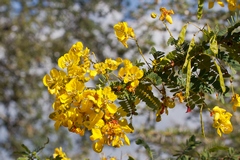
July is without doubt a good time to visit Selous, although the game can be bit patchy as much of it is still living far from the river. From a photography point of view the colours of the land are exceptional and varied, The Sunrises and Sunsets are the best we've seen anywhere in Africa.
The size of Nyerere and the fact that it is difficult to reach and expensive to stay means that you will see little or no traffic once you are off the main road. As it is a Game Reserve you are not confined to any tracks which is very useful when following up on a sighting.
Watch the Selous Revisited I video.
Watch the Selous Revisited II video.